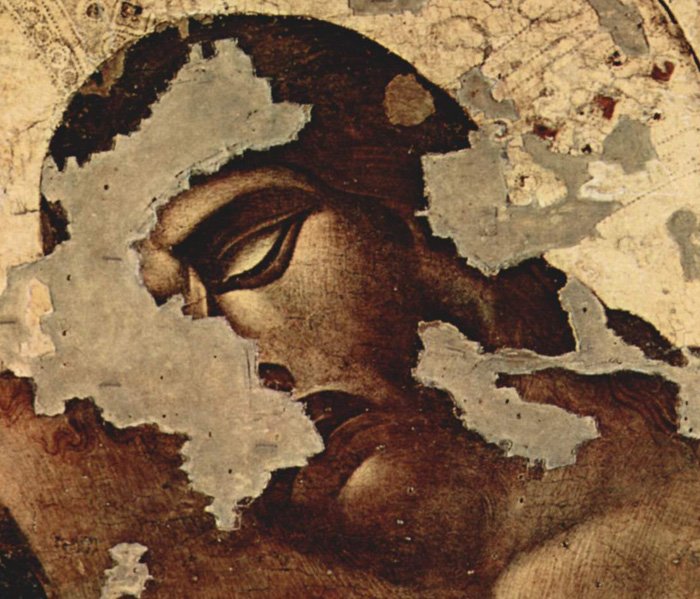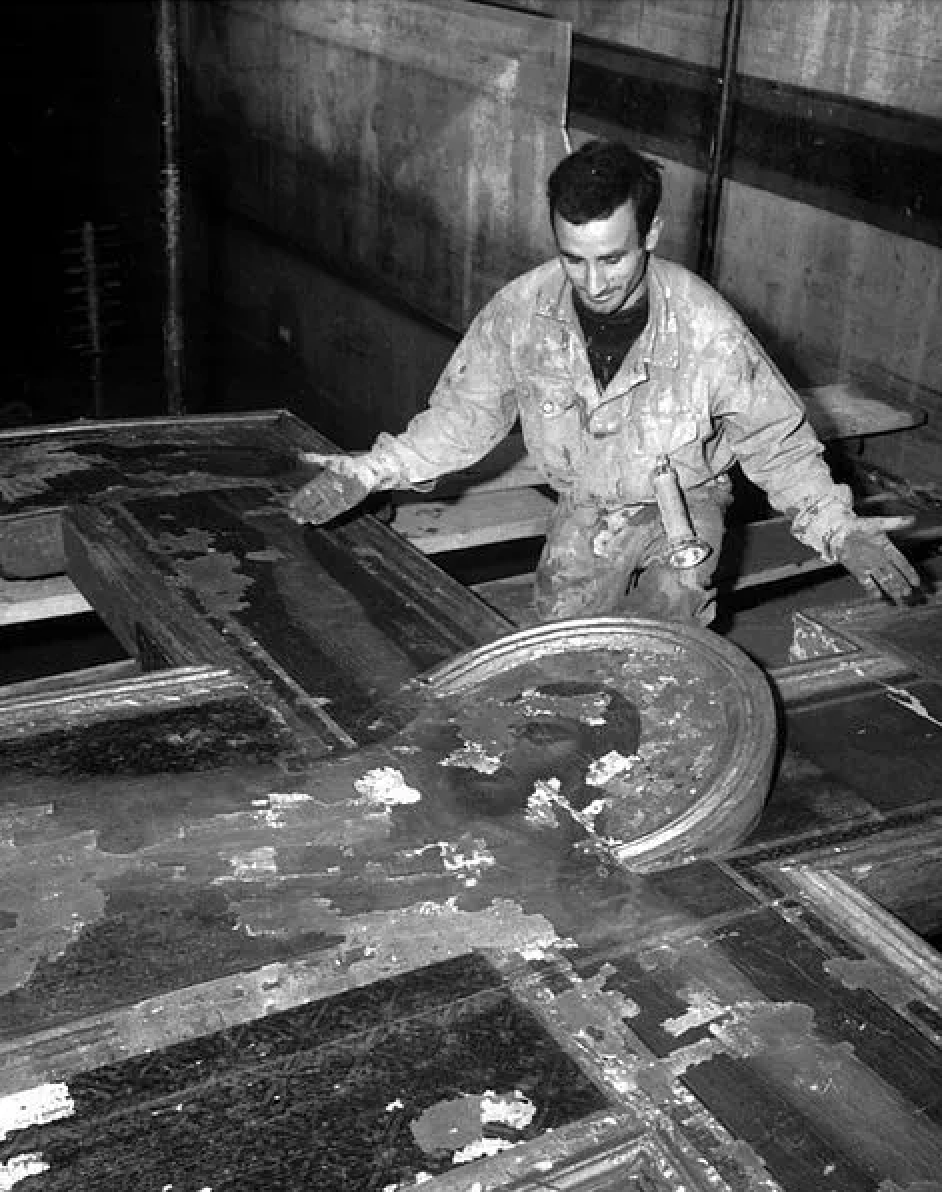The Resurrection of Cimabue's Crucifix
By Jenny O’Gorman
On the Fourth of November 1966, the water from the river Arno surged through the historic streets of Florence, resulting in a number of human fatalities. Ruining millions of paintings, sculptures, manuscripts, and archival documents in metres of water. At once, the structural and aesthetic integrity of artworks centuries apart including Cimabue's Crucifix (c. 1265) and Giorgio Vasari’s The Last Supper (c. 1546-1547) was devastated. Flood markers in the nearby Pietro Parigi Museum attest to the climbing water of Florence’s biblical floods amid the tight network of churches and museums in close proximity to the Arno River.
Cimabue, Crucifix, c. 1265, Distemper on wood panel, Basilica de Santa Croce, Florence
Fifty-six years later, I stood in the darkened refectory of Museo dell’Opera di Santa Croce before Cimabue's Crucifix. I am struck by how Christ’s sorrowful expression takes on a new pathos now it is scabbed with water damage where areas of paint have been completely erased. Although Cimabue draws on iconography typical of the Byzantine period, his innovative modelling of form and closely rendered anatomy is advanced for its time. The artist’s career remains relatively unknown, although we can see evidence of his mastery in both the painting and carpentry in this piece, as much of the original tempera and wood still remain. Sadly though, the Crucifix was once considered as one of the thirteenth-century artist’s best-preserved artworks – I am reminded of the fragility of human creation.
The piece was commissioned in the thirteenth century by the Francian monks and depicts Christus patiens; Christ’s limp body after the agonies of crucifixion are over. This popular, impactful subject matter was often commissioned by the Francian Order to elevate the viewing experience into a spiritual appreciation, eliciting an involved and compassionate response from viewers. Many of their stained glass, frescoes and panel paintings emphasised the human life of holy figures to evoke this reaction and the Crucifix is a prime example of this. As such, the work assumed a primary, but tragically precarious place in the church sacristy despite the troubling precedent of past urban floods. The original position of the panel piece in the sacristy suggests the Florentines forgot, or chose to ignore these risks, with devastating consequences.
Cimabue, Crucifix (detail of Christ’s face), c. 1265, Distemper on wood panel, Basilica de Santa Croce, Florence
Among the photos released by the press at the time of the flood was a deeply moving image of men carrying the cross through the doorway. Volunteers such as these were christened Angeli del fango, angels of the mud for aiding in the recovery effort of Florence’s artistic treasures. The scale of the disaster was both harrowing and exasperating as both volunteers and members of the Franciscan Order spent countless days sieving through sludge for fragments of paint and splintered wood, pulling masterpieces from the floodwater, slick with oil and mud. The international response speaks to the importance and impact of these artworks as people from all religions and cultures came together to salvage them.
Santa Croce after the flood (volunteers lifting Cimabue’s Crucifix), 1966
In the case of Cimabue’s Crucifix, many people were needed to lift the artwork - the waterlogged wooden frame had absorbed so much liquid it had doubled in weight. After the piece had been rescued, it was transported to the limonaia in the magnificent Boboli Gardens, where the focus turned to restoration. The gardens, once owned by the Medici family, became a first-aid site for conservationists, scientists and art historians who came together in an intensive effort to revive the drowned artworks, contending with warping, mould, flaking paint and the cracking and puckering of primed surfaces. After being dried as much as possible, the Crucifix was taken to a restoration laboratory in the Fortezza da Basso for further work.
While many pieces of great significance were damaged beyond repair or completely destroyed, the disaster proved to be a catalyst for profound innovation in conservation techniques. The Crucifix’s original wooden support was stabilised with an internal iron framework – an instance of modern techniques being used sensitively in keeping with Cimabue’s original aesthetic intention, an idea which is most salient in the filling of cracks in the wooden support. Experts used Poplar from the Casentino forest, where Cimabue had obtained the brace for the original wood seven hundred years earlier. Despite this, the appearance of the artwork has certainly been altered by the disaster of 1966 as the masterpiece is still missing its roundel which had previously surmounted the artwork and there are still areas of paint missing.
Santa Croce after the flood (volunteer surveying the damage of Cimabue’s Crucifix), 1966
Nobody knew the value of preserving the memory of great artists better than Vasari whose historic consideration of the 'cyclical view of art’ as a series of ‘birth, maturity and decay’ was instrumental in founding the discipline of Art History. During the flood, his piece The Last Supper, painted on five wooden panels, was submerged underwater for over twelve hours. Perhaps the most tragic aspect of the catastrophe was the fact that generations of artefacts, artworks and architecture were wrecked in one day.
Giorgio Vasari, Last Supper, c. 1546-1547, oil on wood, Basilica de Santa Croce, Florence
In the case of Cimabue’s Crucifix, the conservators chose not to attempt to restore much of the lost paint, but instead to maintain the original genius of the artist, which is clear even from the damaged surface. These tarnished sections are not only a poignant reminder of a traumatic event in the city’s history, but the very presence of the work is a testament to the hope, love and patience of the people who came together to resurrect it.
Notes:
Brink, Joel. ‘Carpentry and Symmetry in Cimabue’s Santa Croce Crucifix.’ The Burlington Magazine, Vol. 120, No. 907 (1978): pp.640,645-653
Cook, William R. The Art of the Franciscan Order in Italy (Leiden, Netherlands: Brill Publishers, 2005)
Payne, Alina. ‘Vasari, Architecture, and the Origins of Historicizing Art.’ RES: Anthropology and Aesthetics, No. 40 (2001): pp.51-76





